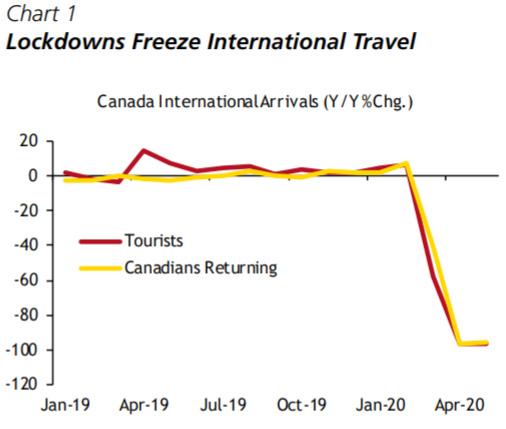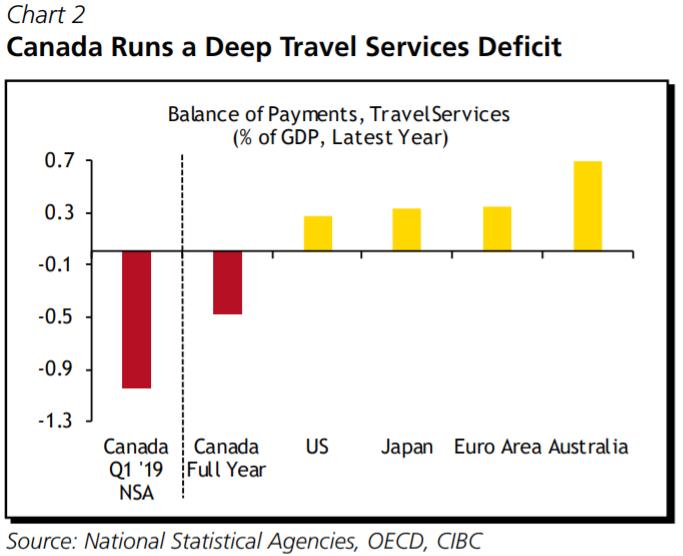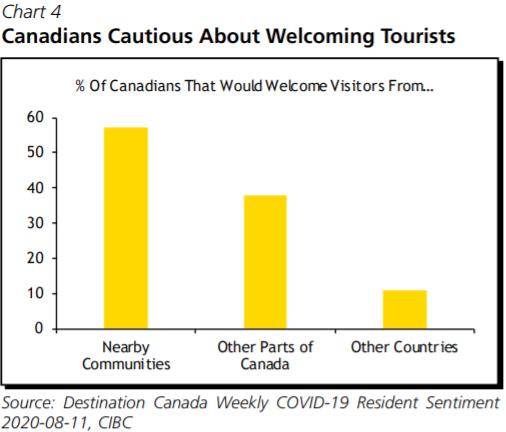
10 minute read
Economic Outlook Q3
The Staycation Economy
Where did you spend your 2020 summer vacation? Here’s a guess — it wasn’t far from home. If you fled to a cottage, a campground, or your own backyard, you were in good company. That’s all owing, of course, to the fear of flying, the barriers to driving somewhere more distant, or cancelled events during the pandemic.
Advertisement
For Canada’s hospitality sector, that represented a deep shock to demand, particularly from the loss of US and overseas tourists during the peak summer season. Depending on the timing of vaccine approval and deployment, that hit could stick around for summer 2021 as well. Make no mistake, this will, overall, be a negative for the economy, such an obvious point that the nearterm damage is not really our focus here. But there are some other twists that will play out in this story that will provide a partially offsetting silver lining to these economic clouds, tied to the spending power of those still working who would have taken more costly vacations. And there may be some new factors in terms of how quickly travel rebounds relative to past recessions.
Fear of Flying, Difficult Driving
Some of the data for this summer’s tourist season is still forthcoming, but what’s available paints a dramatic picture. The number of tourists entering Canada was down 97% in April and May from year ago levels; Canadian tourists returning from visits abroad were down 96% (Chart 1). Not only were road borders shut tight, but despite reassuring steps by airlines and airports, many either feared flying or didn’t want to put up with quarantines at their planned destinations. Those destinations would have included locations with shuttered attractions, or cancelled events.
The overall tourism industry didn’t see quite as large a drop as cross border travel, but the GDP of the accommodation sector was still running at only a third of its prior
year level in April and May. By July, the numbers should look better, since an easing in social distancing rules allowed for a bit more activity. Still, there were barriers to cross-province travel, some official, others from social pressure, and many tourist attractions were still closed in
the summer.
Diverted Dollars
While tourism is an important sector at home, Canadians still spend a lot more abroad than foreign visitors spend here (Chart 2), so there’s a potential silver lining for the trade and current account when travel shuts down. The trade deficit in tourist spending has lightened up in recent years, as indebted Canadians and a weaker currency depressed our travel abroad, against continued growth in inflows. Still, in 2019, Canada ran a deficit of over $10 bn (or roughly 0.5% of GDP), as a nearly balanced picture in the summer is trounced by the deficit in the winter quarter. That’s a big contrast with other major economies, particularly parts of Europe and Australia, where a two way travel freeze will entail losing a major net surplus.

The travel deficit accounted for almost a quarter of Canada’s overall 2.0% of GDP current account deficit last year, so narrowing it is a plus for the Canadian dollar. That said, the overall current account is likely to remain well into deficit as imports delayed by pandemic bottlenecks arrive at our ports in the coming months, while the value of exports is held back by softness in oil prices.
In the winter quarter, the travel trade gap balloons to 1.0% of GDP, including Canadians spending 2.3% of GDP outside the country. If those dollars get diverted to spending at home, that could be a significant lift to the Q1 growth rate. While a January day in Winnipeg or Toronto might not seem to be a close substitute for Florida’s beaches or Arizona’s golf courses, much of that spending diversion could come simply from snowbirds who normally winter in the south opting to stay at home. They will be buying their gasoline and groceries here, keeping the heat running full blast in their Canadian homes, and purchasing other essentials.
There could even be modest spillover benefits to Canada’s tourism sector, offsetting some of the drop in visitors from abroad, if families take the kids skiing locally rather than on a school break trip south, for example. To be clear, that’s still not going to make 2020/21 a winner for Canadian tourism and related activities.
That said, Canadians have also been paring back consumer borrowing and increasing their savings. The combination of limited options for “experience” spending, high debt levels and concerns over job security suggests that some of the funds that would have been spent on travel will end up, for now, not being spent. But a higher savings rate and less consumer debt being accrued during the pandemic will leave a reserve of spending power for when COVID-19 isn’t a threat; including funds that might have been spent outside of Canada had the pandemic not hit.
Plans in the Works
The winter season is still months away, but the lack of sufficient progress on the virus in key US winter travel destinations (Florida and California most notably) suggests that Canadians, particularly retirees, will be wary, even if the border is reopened by then. Uncertainties about health insurance coverage or medical care standards could have some also shying away from non US destinations abroad. Some European countries are reinstating cross border travel restrictions in the wake of upticks in virus case counts.
The data still lean towards a major constraint on travel ahead, particularly across borders. Its notable that Americans, who have the option of leaving their home country for destinations with much lower infection rates, are reporting an even greater reduction in travel intentions abroad than at home (Chart 3). Perhaps that’s due to the need to get on a plane, or simply the recognition that other countries, including Canada, might not welcome them in the next six months. According to a Destination Canada Survey, only 10% of Canadians would welcome the idea of seeing foreign visitors in their communities (Chart 4).


Canadians are also not rushing to get in the travel spirit. Airline booking data is a forward-looking indicator of future passenger volumes, and thus far Canadians are showing little inclination to venture onto planes. That said, domestic travel is showing more of an improvement than flights abroad, reinforcing our view that some foreign travel will be diverted to local spending (Chart 5). Note that according to Destination Canada, domestic travelers already represent 78% of the country’s tourism sector, although much of that would be in the summer.
The Aftermath
Progress towards a vaccine continues to give us hope that, by 2022, or sooner if an effective therapy is found, COVID will become much less of a constraint to travel. A very slow trickle of cases of this disease might remain for years, but should have no more of an impact on travel than other low-odds exposures or risks that travelers always assume. But will travel demand then come roaring back?
Typically, household discretionary spending like travel comes back with a lag after a recession (Chart 6), taking longer to recover than overall consumption. That’s due to the loss of incomes during the slowdown. Travel is, after all, to some extent a luxury. But there are a few reasons to be more optimistic about the recovery path after this

pandemic recession.

For one, the labour income rebound is going to be quite steep compared to past recessions. That’s partly, of course, simply due to the depth of the unemployment trough, but also due to the fact that an all-clear on COVID19 could see a nice snap back in activity and jobs in sectors where underlying demand would have been better if not for health restrictions on supply. As well, the strains on household finances during the crisis, while material, were better cushioned relative to past recessions due to extraordinary levels of government support through programs like the CERB and wage subsidies for employers.
Second, in the case of leisure travel, we’re looking at an activity that, pre-COVID had been growing faster than GDP across the globe. In that, households were showing what economists call their “revealed preference” for devoting more of their consumption towards “experiences” over goods, and there’s no reason to believe that tastes have changed.
Third, and most important, the trough in travel demand in this year’s recession differed from that of past downturns. In addition to the hit from weaker incomes, travel activities were curtailed for those who were willing and financially able to travel, but prevented from doing so due to health restrictions or fears. That’s a source of pent-up demand that would not have been building in past recessions, when those still working and financially able would have continued to travel. They might now be dying to go on vacations again, but for now, are not willing to risk actually dying for their vacation. Post COVID, we expect those frustrated travelers to quickly return.
We’re therefore skeptical of a Bank of Canada survey that came to a different conclusion (Chart 7), with Canadians saying they intend to hold back on travel even when the current situation “normalizes”. For one, such surveys of spending intentions, or even survey data on actual spending, often fail to square with the aggregate data. That could reflect a well-known bias in surveys, in which respondents lean towards giving what they see as the more prudent answer rather than what they actually do, claiming they eat fewer calories, exercise more, and after a recession in particular, avoid spending on non-necessities like travel.

Second, respondents might not have interpreted the key phrase in the question, “when the situation normalizes”, to understand that they were being asked what they will do when COVID has been fully vanquished, or failing to consider what savings they might have piled up while they aren’t travelling.
One part of the travel sector might not, however, return to its full former glory. According to Statista, business travel accounts for nearly 40% of the GDP contribution of tourism in Canada. Some of that is devoted to meeting key customers, touring facilities, and activities that have significant value added. Zoom has been around for nearly a decade and even so, virtual conferences were hardly dominant. We’re very much looking forward to seeing our clients in person when COVID is no longer a threat.
But the use of technology to substitute for traveling to intra-company meetings might linger as a cost saving measure now that it’s successfully been put to the test during the pandemic. Travelling to meet your own employees face to face might be seen as more of a luxury in the years ahead. •
Sources: Bloomberg, Statistics Canada, Bank of Canada Alberta Treasury Board of Finance, CMHC, CREA CIBC World Markets Inc.
JAMES HOBSON, CFA, PM, First Vice-President, Portfolio Manager, Investment Advistor & Chairman’s Council Member 403-260- 0574 james.hobson@cibc.ca
CHARET CHAHAL, CIM, Portfolio Manager, Investment Advisor & Chairman’s Council Memeber 403-260-0440 charet.chahal@cibc.ca
This information, including any opinion, is based on various sources believed to be reliable, but its accuracy cannot be guaranteed and is subject to change. CIBC and CIBC World Markets Inc., their affiliates, directors, officers and employees may buy, sell, or hold a position in securities of a company mentioned herein, its affiliates or subsidiaries, and may also perform financial advisory services, investment banking or other services for, or have lending or other credit relationships with the same. CIBC World Markets Inc. and its representatives will receive sales commissions and/or a spread between bid and ask prices if you purchase, sell or hold the securities referred to above. © CIBC World Markets Inc. 2020. CIBC Wood Gundy is a division of CIBC World Markets Inc., a subsidiary of CIBC and a Member of the Canadian Investor Protection Fund and Investment Industry Regulatory Organization of Canada. James Hobson and Charet Chahal are Investment Advisors with CIBC Wood Gundy in Calgary The views of James Hobson and Charet Chahal do not necessarily reflect those of CIBC World Markets Inc. If you are currently a CIBC Wood Gundy client, please contact your Investment Advisor. Clients are advised to seek advice regarding their particular circumstances from their personal tax and legal advisors.







